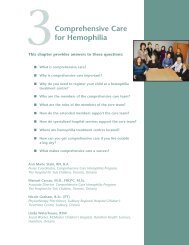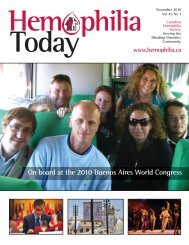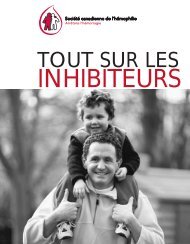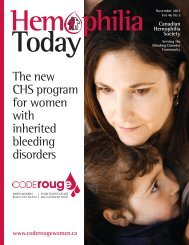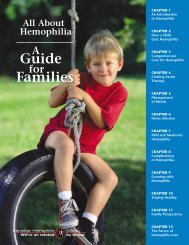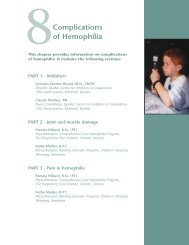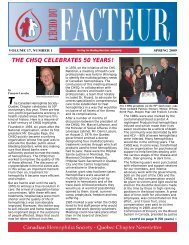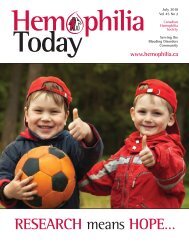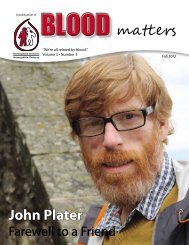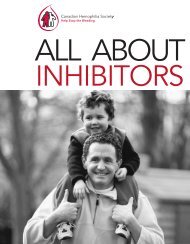news update8 HEMOPHILIA TODAY SUMMER 2002New Emergency Room EducationProgramCathie MorrisAbleeding episode can happen anytime, anywhere. You can be readyto head out on a camping tripwhen your son falls and whacks his headon the front steps. Or you may be reachinginto the car to grab your jacket andsomeone slams the door on your hand.Bleeds can happen anytime and, as a result,one must always beprepared to treat.In order to assistindividuals withbleeding disorders getaccess to the emergencycare they need, theCanadian HemophiliaSociety, with financialassistance from theCanadian BloodServices, Bayer andNovo Nordisk, formedan ER advisory groupcomprised of doctors,nurses, parents andpatients. The outcomeof their efforts has beenthe development of avariety of educationalresources. Among theresources developed area Clinical Focus insert in the Medical Postfor ER physicians, a wallet card entitled theFactor First Treatment Card and a manualcalled A Guide to the ER.With the advent of home infusion,individuals now go to the ER much lessfrequently. ER staff do not have a chance togain experience with bleeding disorders. Tohelp remedy this, a Clinical Focus insertwas written forthe Medical Postwhich offers aguide to theemergencymanagement ofbleedingdisorders for ERstaff. Theobjectives ofthis ClinicalFocus are toraise awarenessamong ER staffabout bleedingdisorders, thecurrenttreatmentsrecommendedand the need forprompttreatment.Remember…FactorFirstA second resource, the Factor FirstTreatment Card, was developed for theindividual with a bleeding disorder to carryin his/her wallet, preferably clipped to thehealth card. This card contains atremendous amount of importantinformation that can help ER staff providetreatment. Included in The Factor FirstTreatment Card is a section to becompleted with your personal treatmentinformation and the phone numbers ofyour Hemophilia Treatment Centre. Theclinics will be provided with overlaystickers so that the information can beupdated at your annual visit. The card is tobe shown to the ER staff when you arrive.It explains your need for prompttreatment, lists your personal treatmentinformation, provides key phone numbersand encourages the ER staff to contactyour hematologist and/or nursecoordinator. Having it clipped to yourhealth card makes it easier for you to findand, in the event that you are unable tospeak for yourself, more easily discoveredby emergency workers.Has a healthcare worker ever asked youthe question, “How long have you hadhemophilia?” Have you waited for hours inthe ER trying to comfort your child in painGUIDELINES FOR EMERGENCYMANAGEMENT OF HEMOPHILIAAND VON WILLEBRAND DISEASEFactorFirstCanadian Hemophilia SocietyAssociation of HemophiliaClinic Directors of Canada(AHCDC)MAJOR/LIFE-THREATEN-ING BLEEDS:• Head (intracranial) and neck• Chest, abdomen, pelvis, spine• Illiopsoas muscle and hip• Massive vaginal hemorrhage• Extremity muscle compartments• Fractures or dislocations• Any deep lacerationMINOR BLEEDS:• Nose (epistaxis)• Mouth (including gums)• Joints (hemarthroses)• Menorrhagia• Abrasions and superficialTREATMENT FOR MAJOR/LIFE-THREATENING BLEEDSHemophilia A: (severe/moderate/mild)Recombinant factor VIII concentrate 40-50 IU/kg.Hemophilia B: (severe/moderate/mild)Recombinant factor IX concentrate 100-120 IU/kg.>15 yrsRecombinant factor IX concentrate 135-160 IU/kg.15 yrsRecombinant factor IX concentrate 50-70 IU/kg.
news updateHEMOPHILIA TODAY SUMMER 2002 9MedicAlert:Protecting Children with Hemophiliawith a serious joint bleed? Have you metan ER physician who has no clue how totreat you but insists there is no need to callyour hematologist? In an attempt to helpindividuals in these situations, the thirdresource, Prepare to Succeed: A Guide to theER is being developed. This guide containspractical suggestions on how to prepare forthat unexpected bleed and what you cando to make things go smoothly at the ER.Individuals are encouraged to develop apersonal plan of what to do in anemergency and who to call. In the backportion of this guide, is a copy ofEmergency Care for Patients withHemophilia: An Instructional Manual forMedical Professionals.Emergencies happen in spite of our bestefforts. All we can do is be prepared tohandle them as best we can.• Be knowledgeable about your bleedingdisorder. Our disorders are rare; thereforeER staff may not be familiar with ourtreatment needs.• Develop an emergency plan with alisting of phone numbers to call.• If you need to go to the ER, have yourHemophilia Treatment Centre orHematologist on call make ERarrangements for you.• Carry your Factor First TreatmentCard and present it to the ER staff.• Obtain and wear Medical ID such asMedicAlert to identify your bleedingdisorder. Identifying yourself as having ableeding disorder is a vital first step in anyemergency!Both the Factor First Treatment Cardand A Guide to the ER will soon be madeavailable through you HemophiliaTreatment Centre. Obtain a copy of each,read them and keep them with you for anemergency. Remember, with such raredisorders, you are your own best resource.Cathie Morris is the mother of a child withsevere factor VIII hemophilia and inhibitors,and a member of the ER Advisory Group.Simon Wong’s life changed instantly with aphone call on Valentines Day 2000 tellinghim his wife Jenny and son Alex had beenseriously injured in a car crash. Ambulancestook them to two different hospitals forcingSimon to make a hard choice. He decided torush to his son, a hemophiliac, who was at riskof bleeding to death. “Alex was covered in bloodand wasn’t moving,” said Simon. Thankfully,Alex’s MedicAlert bracelet was able to speak forhim. The bracelet provided the paramedics withthe vital information they needed to begin thetreatment that was urgent for Alex. At thehospital, the emergency room nurse called theMedicAlert 24-hour emergency hotline andobtained information about Alex that wascrucial to saving his life.On that terrible day Simon Wong lost hiswife and almost lost his son. As his son Alextells anyone who asks, “MedicAlert saved mylife.” That’s why Simon actively supportsMedicAlert. Better than most he understandswhy every person with a medical conditionshould be wearing a MedicAlert bracelet.“Without it,” he says, “their life is at risk.” Simonis committed to helping ensure that everyonewho needs MedicAlert protection is aware of itsbenefits and has access to enrolmentinformation.Canadian MedicAlert Foundation is alsocommitted to providing awareness, educationand access to MedicAlert services to allCanadians. The MedicAlert KidsProtectHIV and Hepatitis CEducational Workshopcontinued from page 6by Barbara Wendland, who bringsextensive knowledge from her research intonutrition and related liver function at theUniversity Health Network in Toronto.Barbara had previously presentedinformation sessions to the Toronto andCentral Ontario Regional HemophiliaSociety in October of 2001. Herpresentation complemented the session onNaturopathy by educating the audience onnutritional substances and supplementsthat may prove to be beneficial for the liverfor those with hepatitis C infection.Finally the CHS HIV and Hepatitis CEducational Workshop program concludedwith a special presentation by MahmoodMorshedi on fertility approaches for HIVserodiscordant couples. This had beenidentified in the needs assessment as a keyAssistance Program is part of this commitmentto make sure that every child who needs theprotection offered by a MedicAlert membershipand bracelet or necklet has access, regardless ofa parent’s ability to pay.Whether at home, in the playground, in theclassroom or on the sports field, children at riskare protected by a MedicAlert bracelet or neckletcustom engraved with a child’s critical medicaland personal information; access by healthcareprofessionals to the 24-hour emergency hotline;and a membership card that lists medicationsalong with personal physicians and emergencycontacts.MedicAlert is a national registered charitythat protects tens of thousands of Canadianchildren with medical conditions, allergies orpersonal needs through its medicalidentification information services.To obtain more information aboutCanadian MedicAlert Foundation programsand services, including the KidsProtect AssistanceProgram, please call 1-800-668-1507.issue for many individuals withhemophilia. This presentation was the firstof its kind at a CHS HIV and hepatitis Cworkshop.The Canadian Hemophilia Societyremains active in ensuring that the needsof community members infected andaffected by HIV and hepatitis C continueto be met. One of the key roles of theCanadian Hemophilia Society is to providethe community with relevant educationalopportunities so that individuals withhemophilia remain active participants inimproving the quality of their own lives.The CHS Youth Committee is envisioningan extension of this HIV and hepatitis Cprogramming initiative to coincide withthe Canadian Hemophilia Society’s 50thanniversary celebrations in 2003. Forfurther information on the contents of theCHS HIV and Hepatitis C EducationalWorkshop, please contact the CanadianHemophilia Society.



